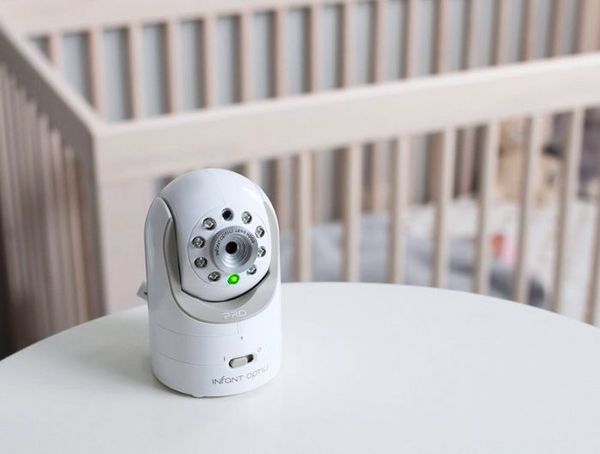If your baby monitor is constantly cutting out, making static noises, or showing a blurry picture it could be a sign of baby monitor interference. Which happens when your baby monitor and other wireless devices use the same frequency band or channel to communicate.
Can Baby Monitors Interfere With Other Electronic Devices?
Most baby monitors use the 2.4 GHz frequency to transmit audio and video signals. This is the same frequency that many devices use, such as WiWi routers, cordless phones, microwaves, Bluetooth speakers, and more.
When two or more devices use the same frequency band, they can interfere with each other and cause signal loss, distortion, or noise. This is called WiFi interference.
WiFi interference can also happen when two or more devices use the same channel within the same frequency. A channel is a smaller segment of the frequency that devices can switch to avoid interference. For example, the 2.4 GHz frequency band has 11 channels in the US and 13 channels in Europe.
However, not all channels are equally spaced apart, and some channels overlap with each other. This means that even if you use different channels for your baby monitor and your WiFi router, they can still interfere with each other if they are too close together.
How To Prevent Baby Monitor Interference?
The best way to prevent baby monitor interference is to avoid using devices that use the same frequency or channel as your baby monitor. Here are some tips to do that:
Digital baby monitor instead of analog
Digital baby monitors use encryption and frequency hopping to reduce interference and increase security. Analog baby monitors use a fixed frequency and can be easily picked up by other devices or people.
WiFi baby monitor instead of radio frequency (RF)
WiFi baby monitors use your home's wireless network to transmit signals instead of using a separate frequency. This means that they will not interfere with other devices that use the same frequency. However, WiFi baby monitors can still experience WiFi interference from other devices that use the same WiFi network.
Different frequency bands
If you have a dual-band WiFi router, you can choose between the 2.4 GHz and the 5 GHz frequency bands for your wireless network. The 5 GHz frequency band has more channels and less interference than the 2.4 GHz one. However, not all devices are compatible with the 5 GHz frequency, and it has a shorter range and weaker signal than the 2.4 GHz one.
Choose different channel for your baby monitor
If you have a WiFi baby monitor or a RF baby monitor that allows you to change channels, you can try switching to a different channel that is less crowded or less overlapping with other devices. You can also change the channel of your WiFi router by accessing its settings through your web browser.
Move your baby monitor away from other wireless devices
The closer two wireless devices are to each other, the more likely they are to interfere with each other. Try moving your baby monitor or your WiFi router away from other devices that use the same frequency or channel, such as cordless phones, microwaves, Bluetooth speakers, etc.
How To Stop Baby Monitor Interference?
If you already have baby monitor interference and you want to fix it quickly, here are some steps you can take:
Turn off or unplug other wireless devices
Sometimes, simply turning off or unplugging another wireless device that uses the same frequency or channel as your baby monitor can solve the problem. Try turning off or unplugging one device at a time and check if your baby monitor signal improves.
Switch to a wired network
If you have a computer or other devices that use wireless computer networks (such as laptops, tablets, smartphones, etc.), you can try switching them to a wired network instead of a wireless one. This will free up some bandwidth and reduce WiFi interference for your baby monitor.
Reset your baby monitor or your WiFi router
Sometimes, resetting your baby monitor or your WiFi router can help them reconnect and find a better channel or frequency to use. To reset your baby monitor, follow the instructions in its manual. To reset your WiFi router, press and hold the reset button on its back for about 10 seconds until its lights blink.
Upgrade your router
Newer routers often have features that help minimize interference between wireless networks and other devices. Look for a router with dual-band or tri-band capabilities, which allow you to separate your WiFi network from the frequency used by most baby monitors.
Contact the manufacturer for support
If none of the above steps work, you may need to contact the manufacturer of your baby monitor or your WiFi router for support. They may be able to help you troubleshoot the problem or offer you a replacement or an upgrade.
Try a different baby monitor model
If none of these solutions work for you, you may want to consider getting a new baby monitor that uses a different frequency band or technology than your current one.
For example, you can get a digital baby monitor that uses DECT (Digital Enhanced Cordless Telecommunications) technology instead of WiFi technology. DECT baby monitors use a dedicated frequency band (1.9 GHz) that is less crowded and less prone to interference than WiFi bands (2.4 GHz and 5 GHz). They also offer better sound quality and security than analog or WiFi baby monitors.
Conclusion
Baby monitor interference can be frustrating and annoying for parents who want to keep an eye and an ear on their little ones while they sleep. However, by following these tips and steps, you can prevent and fix baby monitor interference and enjoy a clear and reliable signal from your baby monitor.
Thank you for reading Mother Bear Reviews, your favorite parenting blog!









